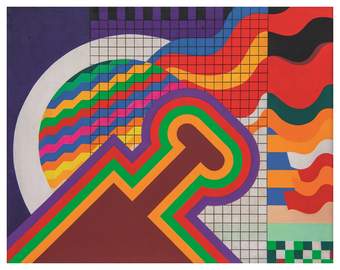
Mohammed Chabâa, Untitled, 1977 © Mohammed Chabâa Estate

Mohammed Chabâa, Untitled, 1977 © Mohammed Chabâa Estate
Tate St Ives presents the first major museum exhibition of the Casablanca Art School; it is also the first time that most of these works have been seen in the UK.
The Casablanca Art School’s revolutionary approach proposed a bold new visual culture following Morocco’s independence in 1956. Reflecting a new social awareness, artist-professors including Farid Belkahia, Mohammed Chabâa and Mohamed Melehi transformed this institution by encouraging artistic experiments, looking beyond western academic traditions and drawing on existing local culture. This exhibition will explore how the teachers and students of the Casablanca Art School combined traditional Berber skills, materials and visual languages with modernist influences from Europe and North America, creating a space to reimagine Moroccan contemporary art and its relationship with everyday life.
Working across painting, sculpture, graphic design, architectural mural painting and many other media, the artists associated with the school placed art into public spaces and promoted it as a shared experience. This landmark exhibition brings together works by more than twenty artists, to include vibrant, abstract paintings, urban murals, craft, typology, graphics and ceramics, alongside rarely seen print archives, vintage journals and photographs.
The exhibition will show how the main exponents of the group looked beyond western styles and teaching, encouraging students to explore abstract art and reconnect with Afro-Arab culture. Farid Belkahia, appointed Director of the Casablanca Art School, expanded teaching staff to include Mohamed Melehi and Toni Mariani (from 1964), Bert Flint (from 1965) and Mohammed Chabâa (from 1966), heralding memorable years of artistic progress. This network of artists looked to the Bauhaus art school – which removed distinctions between art, craft, design and architecture – and reimagined its vision within an Afro-Berber context.
Looking back at key moments in the development of the movement, visitors to the exhibition will see how the group experimented with cross-disciplinary practices to form a new perspective, resulting in a new wave of avant-garde making that merged influences from decorative, moving and written forms. One important platform was the Plastic Presence exhibition which took place outdoors in the Jemaa el-Fna Square in Marrakech and the 18 November Square in Casablanca, and which remains a significant turning point in the history of Moroccan art. Other seminal exhibitions will be explored, such as the 1968 student exhibition which took place at the Arab League Park Pavilion. The exhibition marked a peak of collective innovation and creativity; multicultural experiments of staff and students created a new perspective for the post-colonial era.
Throughout the 1970s the movement grew as the influence of the school travelled further afield. The 1974 Baghdad Arab Art Biennial brought together over 600 works including artists from the new wave of Moroccan art. The 1978 inaugural Asilah Cultural Moussem-Festival, meanwhile, which was co-founded by Mohamed Melehi and Mohamed Benaïssa and took place across the civic spaces of the town of Asilah, remains one of the many enduring legacies of the cultural activism of the Casablanca Art School.